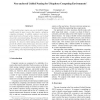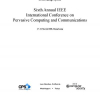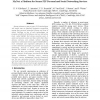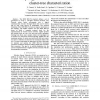PERCOM
2008
ACM
14 years 11 months ago
2008
ACM
This paper proposes a multiagent based virtual community as a new means to support pervasive computing services. We give a conceptual definition of the concept of Place-Based Virt...
PERCOM
2008
ACM
14 years 11 months ago
2008
ACM
Users and developers require some way to identify by human readable names the many resources that comprise a ubiquitous computing environment. In addition, naming in such environm...
PERCOM
2008
ACM
14 years 11 months ago
2008
ACM
Decentralized Voice over IP networks are a promising alternative to classical server-based SIP networks especially in disaster areas or areas without centralized infrastructure. T...
PERCOM
2008
ACM
14 years 11 months ago
2008
ACM
A promising architecture for remote healthcare monitoring involves the use of a pervasive device (such as a cellular phone), which aggregates data from multiple body-worn medical ...
PERCOM
2008
ACM
14 years 11 months ago
2008
ACM
PERCOM
2008
ACM
14 years 11 months ago
2008
ACM
Many pervasive computing systems have been built for using mobile computers to interact with networked devices. To deploy a device's user-interface, several systems dynamical...
PERCOM
2008
ACM
14 years 11 months ago
2008
ACM
Recent advances in peer-to-peer (P2P) technologies will enable users to establish ubiquitous connectivity among their personal networked devices and those of others. Building on t...
PERCOM
2008
ACM
14 years 11 months ago
2008
ACM
PERCOM
2008
ACM
14 years 11 months ago
2008
ACM
In this paper, we describe an information agent, that resides on a mobile computer or personal digital assistant (PDA), that can autonomously acquire sensor readings from pervasiv...
PERCOM
2008
ACM
14 years 11 months ago
2008
ACM
The IEEE 802.15.4 standard defines a set of procedures to set-up a Low-Rate Wireless Personal Area Network where nodes self-organize into a logical communication structure through ...




